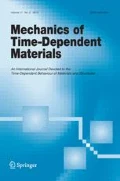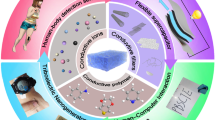Abstract
The shape-memory response (SMR) of “click” thiol-epoxy polymers produced using latent catalysts, with different network structure and thermo-mechanical properties, was tested on unconstrained shape-recovery processes under isothermal conditions. Experiments at several programming temperatures (\(T_{\mathrm{prog}}\)) and isothermal-recovery temperatures (\(T_{\mathrm{iso}}\)) were carried out, and the shape-memory stability was analyzed through various consecutive shape-memory cycles. The temperature profile during the isothermal-recovery experiments was monitored, and it showed that the shape-recovery process takes place while the sample is becoming thermally stable and before stable isothermal temperature conditions are eventually reached. The shape-recovery process takes place in two different stages regardless of \(T_{\mathrm{iso}}\): a slow initial stage until the process is triggered at a temperature strongly related with the beginning of network relaxation, followed by the typical exponential decay of the relaxation processes until completion at a temperature below or very close to \(T_{\mathrm{g}}\). The shape-recovery process is slower in materials with more densely crosslinked and hindered network structures. The shape-recovery time (\(t_{\mathrm{sr}}\)) is significantly reduced when the isothermal-recovery temperature \(T_{\mathrm{iso}}\) increases from below to above \(T_{\mathrm{g}}\) because the network relaxation dynamics accelerates. However, the temperature range from the beginning to the end of the recovery process is hardly affected by \(T_{\mathrm{iso}}\); at higher \(T_{\mathrm{iso}}\) it is only slightly shifted to higher temperatures. These results suggest that the shape-recovery process can be controlled by changing the network structure and working at \(T_{\mathrm{iso}} < T_{\mathrm{g}}\) to maximize the effect of the structure and/or by increasing \(T_{\mathrm{iso}}\) to minimize the effect but increasing the shape-recovery rate.










Similar content being viewed by others

References
Arrieta, J.S., Diani, J., Gilormini, P.: Cyclic and monotonic testing of free and constrained recovery properties of a chemically crosslinked acrylate. J. Appl. Polym. Sci. 131, 39813–39820 (2014a)
Arrieta, S., Diani, J., Gilormini, P.: Experimental characterization and thermoviscoelastic modeling of strain and stress recoveries of an amorphous polymer network. Mech. Mater. 68, 95–103 (2014b)
Belmonte, A., Guzmán, D., Fernández-Francos, X., De la Flor, S.: Effect of the network structure and programming temperature on the shape-memory response of thiol-epoxy “click” systems. Polymers 7, 2146–2164 (2015)
Berg, G.J., McBride, M.K., Wang, C., Bowman, C.N.: New directions in the chemistry of shape memory polymers. Polymer 55, 1–24 (2014)
Binder, W.H., Sachsenhofer, R.: “Click” chemistry in polymer and materials science. Macromol. Rapid Commun. 28, 15–54 (2007)
Brändle, A., Khan, A.: Thiol–epoxy “click” polymerization: efficient construction of reactive and functional polymers. Polym. Chem. 3, 3224 (2012)
Carlborg, C.F., Vastesson, A., Liu, Y., Van Der Wijngaart, W., Johansson, M., Haraldsson, T.: Functional off-stoichiometry thiol-ene-epoxy thermosets featuring temporally controlled curing stages via an UV/UV dual cure process. J. Polym. Sci., Part A, Polym. Chem. 52, 2604–2615 (2014)
Chen, X., Nguyen, T.D.: Influence of thermoviscoelastic properties and loading conditions on the recovery performance of shape memory polymers. Mech. Mater. 43, 127–138 (2011)
Diani, J., Gilormini, P., Frédy, C., Rousseau, I.: Predicting thermal shape memory of crosslinked polymer networks from linear viscoelasticity. Int. J. Solids Struct. 49, 793–799 (2012)
Fan, M., Yu, H., Li, X., Cheng, J., Zhang, J.: Thermomechanical and shape-memory properties of epoxy-based shape-memory polymer using diglycidyl ether of ethoxylated bisphenol-A. Smart Mater. Struct. 22, 055034 (2013)
Feldkamp, D.M., Rousseau, I.A.: Effect of the deformation temperature on the shape-memory behavior of epoxy networks. Macromol. Mater. Eng. 295, 726–734 (2010)
Feldkamp, D.M., Rousseau, I.A.: Effect of chemical composition on the deformability of shape-memory epoxies. Macromol. Mater. Eng. 296, 1128–1141 (2011)
Flores, M., Tomuta, A.M., Fernández-Francos, X., Ramis, X., Sangermano, M., Serra, A.: A new two-stage curing system: thiol-ene/epoxy homopolymerization using an allyl terminated hyperbranched polyester as reactive modifier. Polymer 54, 5473–5481 (2013)
Ge, Q., Yu, K., Ding, Y., Jerry Qi, H.: Prediction of temperature-dependent free recovery behaviors of amorphous shape memory polymers. Soft Matter 8, 11098 (2012)
Guzmán, D., Ramis, X., Fernández-Francos, X., Serra, A.: New catalysts for diglycidyl ether of bisphenol a curing based on thiol-epoxy click reaction. Eur. Polym. J. 59, 377–386 (2014)
Hager, M.D., Bode, S., Weber, C., Schubert, U.S.: Shape memory polymers: past, present and future developments. Prog. Polym. Sci. 49–50, 3–33 (2015)
Jin, K., Heath, W.H., Torkelson, J.M.: Kinetics of multifunctional thiol-epoxy click reactions studied by differential scanning calorimetry: effects of catalysis and functionality. Polymer 81, 70–78 (2015)
Lakhera, N., Yakacki, C.M., Nguyen, T.D., Frick, C.P.: Partially constrained recovery of (meth)acrylate shape-memory polymer networks. J. Appl. Polym. Sci. 126, 72–82 (2012)
Lendlein, A., Sauter, T.: Shape-memory effect in polymers. Macromol. Chem. Phys. 214, 1175–1177 (2013)
Leng, J., Yu, K., Sun, J., Liu, Y.: Deployable morphing structure based on shape memory polymer. Aircr. Eng. Aerosp. Technol. 87, 218–223 (2015)
Leonardi, A.B., Fasce, L.A., Zucchi, I.A., Hoppe, C.E., Soulé, E.R., Pérez, C.J., Williams, R.J.J.: Shape memory epoxies based on networks with chemical and physical crosslinks. Eur. Polym. J. 47, 362–369 (2011)
Liu, Y., Han, C., Tan, H., Du, X.: Thermal, mechanical and shape memory properties of shape memory epoxy resin. Mater. Sci. Eng. A. 527, 2510–2514 (2010)
Loureiro, R.M., Amarelo, T.C., Abuin, S.P., Soulé, E.R., Williams, R.J.J.: Kinetics of the epoxy–thiol click reaction initiated by a tertiary amine: calorimetric study using monofunctional components. Thermochim. Acta 616, 79–86 (2015)
Pandini, S., Bignotti, F., Baldi, F., Passera, S.: Network architecture and shape memory behavior of cold-worked epoxies. J. Intell. Mater. Syst. Struct. 24, 1583–1597 (2013)
Pascault, J.-P., Sautereau, H., J, V., R, W.J.J.: Thermosetting Polymers. CRC Press, Boca Raton (2002)
Rousseau, I.A., Xie, T.: Relationship between materials properties and shape memory behavior in epoxy-amine polymers. In: Materials Research Society Symposium Proceedings, pp. 31–36 (2009)
Rousseau, I.A.: Challenges of shape memory polymers: a review of the progress toward overcoming SMP’s limitations. Polym. Eng. Sci. 48, 2075–2089 (2008)
Santhosh Kumar, K.S., Biju, R., Reghunadhan Nair, C.P.: Progress in shape memory epoxy resins. React. Funct. Polym. 73, 421–430 (2013)
Santiago, D., Fabregat-Sanjuan, A., Ferrando, F., De la Flor, S.: Recovery stress and work output in hyperbranched poly(ethyleneimine)-modified shape-memory epoxy polymers. J. Polym. Sci., Part B, Polym. Phys. 54(10), 1002–1013 (2016)
Santiago, D., Fernández-Francos, X., Ferrando, F., De la Flor, S.: Shape-memory effect in hyperbranched poly(ethyleneimine)-modified epoxy thermosets. J. Polym. Sci., B, Polym. Phys. 53(13), 924–933 (2015)
Scalet, G., Auricchio, F., Bonetti, E., Castellani, L., Ferri, D., Pachera, M., Scavello, F.: An experimental, theoretical and numerical investigation of shape memory polymers. Int. J. Plast. 67, 127–147 (2015)
Song, J.J., Chang, H.H., Naguib, H.E.: Biocompatible shape memory polymer actuators with high force capabilities. Eur. Polym. J. 67, 186–198 (2015)
Sun, L., Huang, W.M., Ding, Z., Zhao, Y., Wang, C.C., Purnawali, H., Tang, C.: Stimulus-responsive shape memory materials: a review. Mater. Des. 33, 577–640 (2012)
Tandon, G.P., Gibson, T., Shumaker, J., Coomer, R., Baur, J., Justice, R.S.: Processing and characterization of novel bismaleimide-based shape memory polymer composites. In: ASME 2012 Conference on Smart Materials, Adaptive Structures and Intelligent Systems, SMASIS 2012, vol. 1, pp. 19–25 (2012)
Tandon, G.P., McClung, A.J., Bauer, J.W.: Shape-Memory Polymers for Aerospace Applications. DEStech Publications (2016)
Williams, M.L., Landel, R.F., Ferry, J.D.: The temperature dependence of relaxation mechanisms in amorphous polymers and other glass-forming liquids. J. Am. Chem. Soc. 77, 3701–3707 (1955)
Yakacki, C.M., Shandas, R., Lanning, C., Rech, B., Eckstein, A., Gall, K.: Unconstrained recovery characterization of shape-memory polymer networks for cardiovascular applications. Biomaterials 28, 2255–2263 (2007)
Yakacki, C.M., Shandas, R., Safranski, D., Ortega, A.M., Sassaman, K., Gall, K.: Strong, tailored, biocompatible shape-memory polymer networks. Adv. Funct. Mater. 18, 2428–2435 (2008a)
Yakacki, C.M., Willis, S., Luders, C., Gall, K.: Deformation limits in shape-memory polymers. Adv. Eng. Mater. 10, 112–119 (2008b)
Zhao, Q., Qi, H.J., Xie, T.: Recent progress in shape memory polymer: new behavior, enabling materials, and mechanistic understanding. Prog. Polym. Sci. 49–50, 1–42 (2015)
Acknowledgements
The authors would like to thank MICINN (MAT2014-53706-C03-01 and MAT2014-53706-C03-02) and Generalitat de Catalunya (2014-SGR-67) for financial support.
Author information
Authors and Affiliations
Corresponding author
Rights and permissions
About this article
Cite this article
Belmonte, A., Fernández-Francos, X., De la Flor, S. et al. Network structure dependence on unconstrained isothermal-recovery processes for shape-memory thiol-epoxy “click” systems. Mech Time-Depend Mater 21, 133–149 (2017). https://doi.org/10.1007/s11043-016-9322-z
Received:
Accepted:
Published:
Issue Date:
DOI: https://doi.org/10.1007/s11043-016-9322-z



